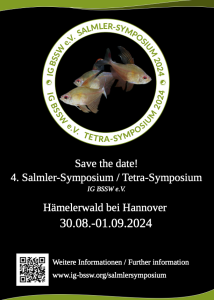| Der erste Teil des Fundamentes ist gesetzt: Es gibt die ersten Eckdaten für den Cory Congress 2024. Continue reading |
Fish Groups
Corrections of some species names from Dias et al. (2024)
The study “Phylogenetic analyses in the complex Neotropical subfamily Corydoradinae (Siluriformes: Callichthyidae) with a new classification based on morphological and molecular data” by Dias et al. 2024 recently published a long-awaited revision of the popular armoured catfishes. Continue reading
Tetra-Symposium 2024
the first step has been done: As previously announced, these are the key dates for this year’s Tetra symposium.
The date is the weekend from 30th of August – 1st of September 2024 (with arrival on Friday), the venue is:
Hotel & Restaurant Fricke
Niedersachsenstr. 8
D-31275 Lehrte/OT Hämelerwald
+49 (0) 5175 7796
info@hotelfricke.de
www.hotelfricke.de
A double room including breakfast costs 104 €, a single room between 72 and 82 €, depending on the room type and of course also including breakfast. For single rooms, those who book early get the cheaper option. Please book the rooms as early as possible under the keyword: “BSSW” or “Tetra Symposium”!
As always, we are currently working on a varied programme for tetras, which will be announced soon. We are also happy to accept offers or requests for lectures. Because this is the only way to organise an important part of the event in addition to all the discussions we will share.
Best regards from the organising team
Armin SENGER – Eckhard FISCHER – Achim WERCKENTHIN
The Zebra Otocinclus, a species with two faces
The Zebra Otocinclus is probably the most spectacular and most attractive Otocinclus species for the aquarium hobby. It has been known for some time that there are two forms of the species described in 2004 as O. cocama: one from the lower Río Ucayali and another one from the Río Tigre. Both rivers are tributaries to the Río Marañón, which ultimately flows into the Amazon. While the Ucayali form, on which the description is based, has been exported for the aquarium trade since around the turn of the millennium, it is mainly the Tigre form that has been on the market in recent years, at least in Germany. Both populations can be clearly distinguished by their stripe pattern. The question of whether the populations can also be distinguished morphologically and genetically, and thus also whether they are merely variants of one species or two distinct species, was investigated by Eduardo MEJIA and Roberto E. REIS and recently published. Continue reading
L 267 described as Ancistrus yanesha
The Ancistrus species L267, already presented by Claus SCHAEFER in the DATZ in 1998, has now been described by NEUHAUS et al. in the current issue of the Journal of Fish Biology (DOI: 10.1111/jfb.15637) as Ancistrus yanesha. Continue reading
Der Zebraharnischwels ist Heimtier des Jahres 2024
Zum zweiten Mal ernannte der ZZF (Zentralverband Zoologischer Fachbetriebe Deutschlands e.V.) kürzlich ein “Heimtier des Jahres” und für 2024 fiel die Wahl auf den Zebrawels (Hypancistrus zebra). Continue reading
Corydoras vittatus NIJSSEN 1971
From a tributary of the Rio Itapicuru (Maranhão, northeastern Brazil) comes Corydoras vittatus NIJSSEN 1971, an often-overlooked Corydoras, of which one reads and hears far too seldom. Continue reading
IG BSSW-News (Tetras): Pseudochalceus kyburzi SCHULTZ, 1966
taken from report 3-2020
The species was named after the Swiss ornamental fish exporter William A. KYBURZ, who was active in Columbia back then. Continue reading
Rückblick: 3. Salmlersymposium
Nach coronabedingten Absagen in den Jahren zuvor konnte am 12. und 13. November 2022 die dritte Auflage des Salmlersymposiums stattfinden. Continue reading
IG BSSW-News (Loaches): Canthophrys gongota
Recently I received interesting pictures from our chairman, showing the loach Canthophrys gongota (syn. Somileptes), , which he had taken at the English shop Pier Aquatics. Continue reading
